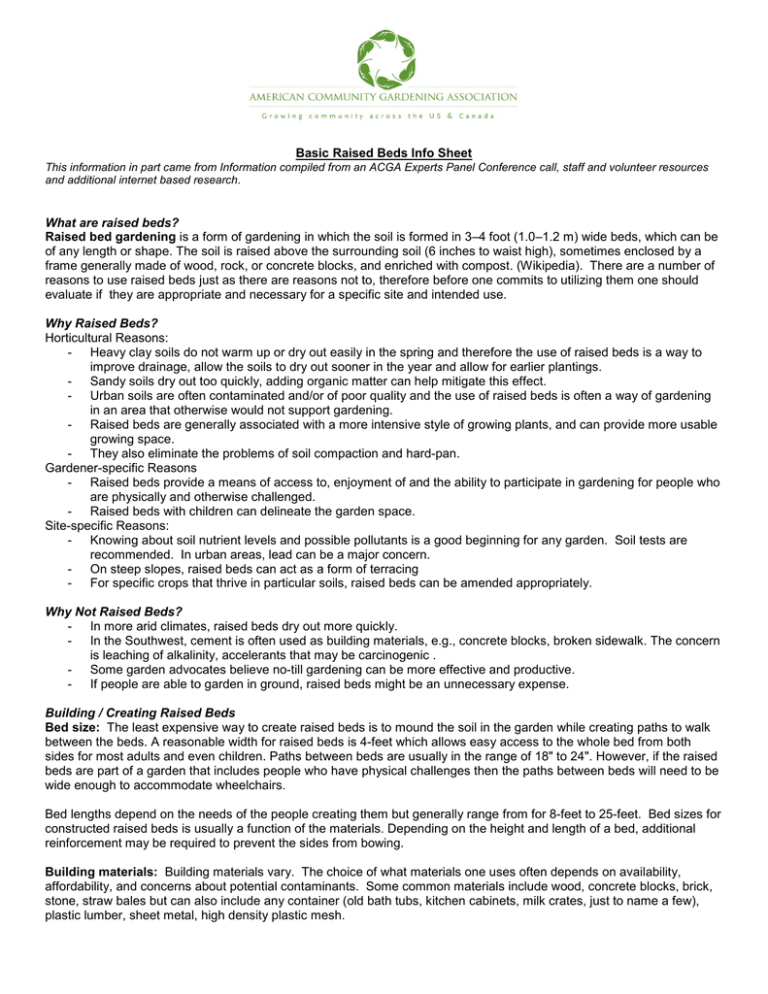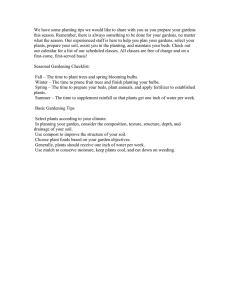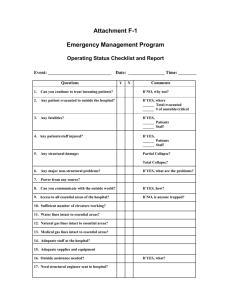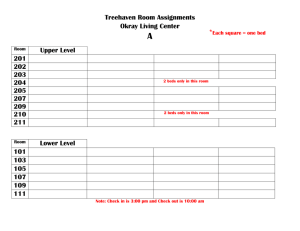Basic Raised Beds Info Sheet What are raised beds?
advertisement

Basic Raised Beds Info Sheet This information in part came from Information compiled from an ACGA Experts Panel Conference call, staff and volunteer resources and additional internet based research. What are raised beds? Raised bed gardening is a form of gardening in which the soil is formed in 3–4 foot (1.0–1.2 m) wide beds, which can be of any length or shape. The soil is raised above the surrounding soil (6 inches to waist high), sometimes enclosed by a frame generally made of wood, rock, or concrete blocks, and enriched with compost. (Wikipedia). There are a number of reasons to use raised beds just as there are reasons not to, therefore before one commits to utilizing them one should evaluate if they are appropriate and necessary for a specific site and intended use. Why Raised Beds? Horticultural Reasons: - Heavy clay soils do not warm up or dry out easily in the spring and therefore the use of raised beds is a way to improve drainage, allow the soils to dry out sooner in the year and allow for earlier plantings. - Sandy soils dry out too quickly, adding organic matter can help mitigate this effect. - Urban soils are often contaminated and/or of poor quality and the use of raised beds is often a way of gardening in an area that otherwise would not support gardening. - Raised beds are generally associated with a more intensive style of growing plants, and can provide more usable growing space. - They also eliminate the problems of soil compaction and hard-pan. Gardener-specific Reasons - Raised beds provide a means of access to, enjoyment of and the ability to participate in gardening for people who are physically and otherwise challenged. - Raised beds with children can delineate the garden space. Site-specific Reasons: - Knowing about soil nutrient levels and possible pollutants is a good beginning for any garden. Soil tests are recommended. In urban areas, lead can be a major concern. - On steep slopes, raised beds can act as a form of terracing - For specific crops that thrive in particular soils, raised beds can be amended appropriately. Why Not Raised Beds? - In more arid climates, raised beds dry out more quickly. - In the Southwest, cement is often used as building materials, e.g., concrete blocks, broken sidewalk. The concern is leaching of alkalinity, accelerants that may be carcinogenic . - Some garden advocates believe no-till gardening can be more effective and productive. - If people are able to garden in ground, raised beds might be an unnecessary expense. Building / Creating Raised Beds Bed size: The least expensive way to create raised beds is to mound the soil in the garden while creating paths to walk between the beds. A reasonable width for raised beds is 4-feet which allows easy access to the whole bed from both sides for most adults and even children. Paths between beds are usually in the range of 18" to 24". However, if the raised beds are part of a garden that includes people who have physical challenges then the paths between beds will need to be wide enough to accommodate wheelchairs. Bed lengths depend on the needs of the people creating them but generally range from for 8-feet to 25-feet. Bed sizes for constructed raised beds is usually a function of the materials. Depending on the height and length of a bed, additional reinforcement may be required to prevent the sides from bowing. Building materials: Building materials vary. The choice of what materials one uses often depends on availability, affordability, and concerns about potential contaminants. Some common materials include wood, concrete blocks, brick, stone, straw bales but can also include any container (old bath tubs, kitchen cabinets, milk crates, just to name a few), plastic lumber, sheet metal, high density plastic mesh. Cypress, cedar, fir, locust and pine treated with linseed oil as a preservative are always good, safe choices. Walnut, while resistant to rot, is not a good choice do to its allopathic effects on plants. Some gardens use plastic or treated lumber and there is lots of information for and against both types of materials, as is also true for creosoted railroad ties and tires. Barriers: If the raised beds are being created or constructed in or over soil that is not contaminated then there is no need to use a barrier between the beds and the soil. If however, the beds are being built over contaminated soils, then a barrier between the growing medium and the contaminated soils is a good idea. Landscape fabric which allows moisture to pass through while suppressing weeds and plant roots from growing through is often used. On heavily contaminated soils quite often a base of gravel covered by an additional layer of landscape fabric and then the growing medium is used to provide good separation. Tips from the Conference Call Materials to use (or not use) • Use linseed oil to preserve wood • Locust, cedar & cypress are good wood options • Potentially railroad ties if you plant a foot out. • Master gardeners in some areas use treated lumber – much less toxic than in the past. • Get soil tested, Extension offices will sometimes test soil. • Green Cement may be a potential alternative • In arid Southwest, maybe better to utilize straw bales, cobb, or adobe • Building supply companies sometimes have damaged goods or lumber that they’ll donate, sometimes have grants for community gardens. Size • • • • 4’ is good width for working on both sides. 4’x25’ – makes calculations easy because you’re always working 100 s.f. 10x20, put fence board as walkways, 4’x4’ easy to reach from any direction. If using really long beds, 20-25 feet reinforce with rebar or giant bolt across the middle work, to prevent bowing in the middle Construction • San Antonio uses raised (elevated) beds for people with disabilities. They came up with a design for 2-4x4 boxes straddled in middle by bench. • On participant used concrete block, capped blocks with wood to allow for sitting, more rectangular style, in a horseshoe style. Another community garden used a mix of wood, douglas fir, cedar, redwood and raised 10”. • Cedar beds done in tiers for ease in filling and can then be moved if necessary. • Anything can be used (milk crates, old dresser drawers, kitchen cabinets, also children’s pools on asphalt) • Fill with yard waste, compost , (one participant used Mel Bartholomew’s book) 1/3 compost, peat moss, vermiculite • Beet’s Peat is a more environmentally friendly peat made of coconut hulls. Ideas for barriers against contaminated soils and gophers: • Used heavy-weight plastic and heavy rains created a pond. • Landscaping fabric cloth under beds • Not all plants take up contaminates • Paved over soil, then built new soil on top. • Hardware cloth, screen or netting for gophers. Additional Resources: John Jeavons, How to Grow More Vegetables ATTRA: The NCAT Sustainable Agriculture Project - https://attra.ncat.org/ How To Garden Advice.com - http://www.howtogardenadvice.com/garden_info/raised_bed_gardening.html eXtension - http://www.extension.org/ About.com-http://organicgardening.about.com/od/startinganorganicgarden/a/raisedbed.htm Most state Extension agencies can help with locating soil testing services. Other good sources of information include: Cornell Waste Management Institute: http://cwmi.css.cornell.edu/soilquality.htm Healthy Soils, Healthy Communities: http://cwmi.css.cornell.edu/healthysoils.htm



